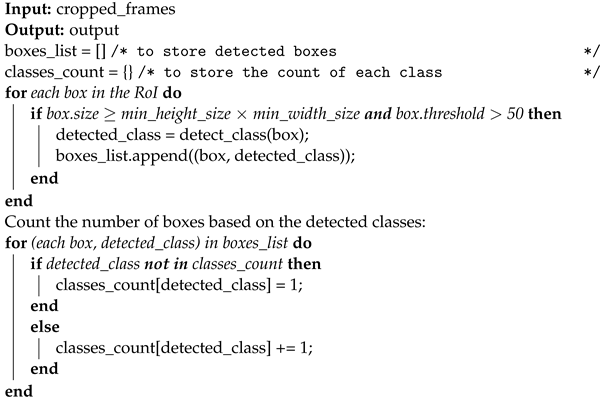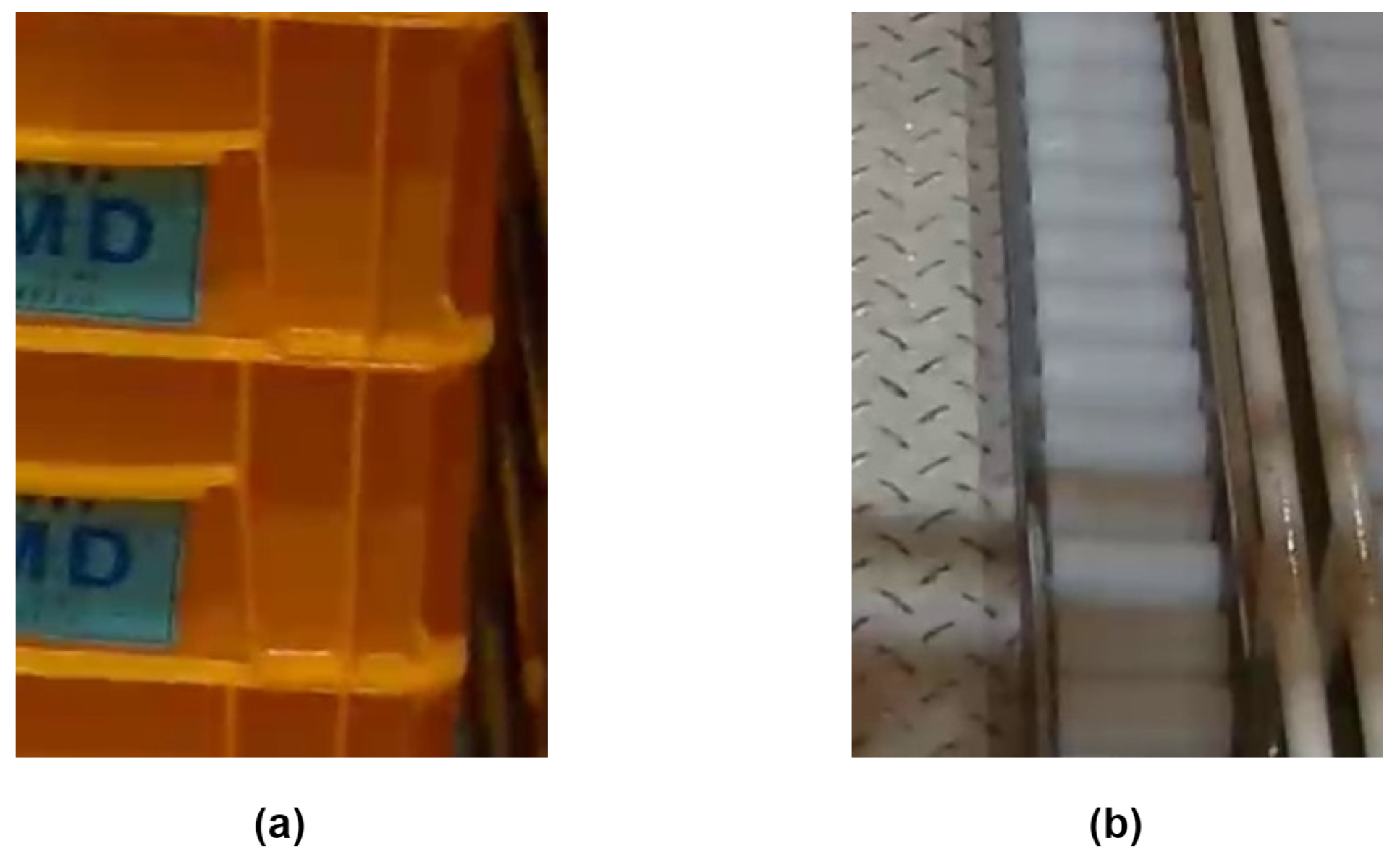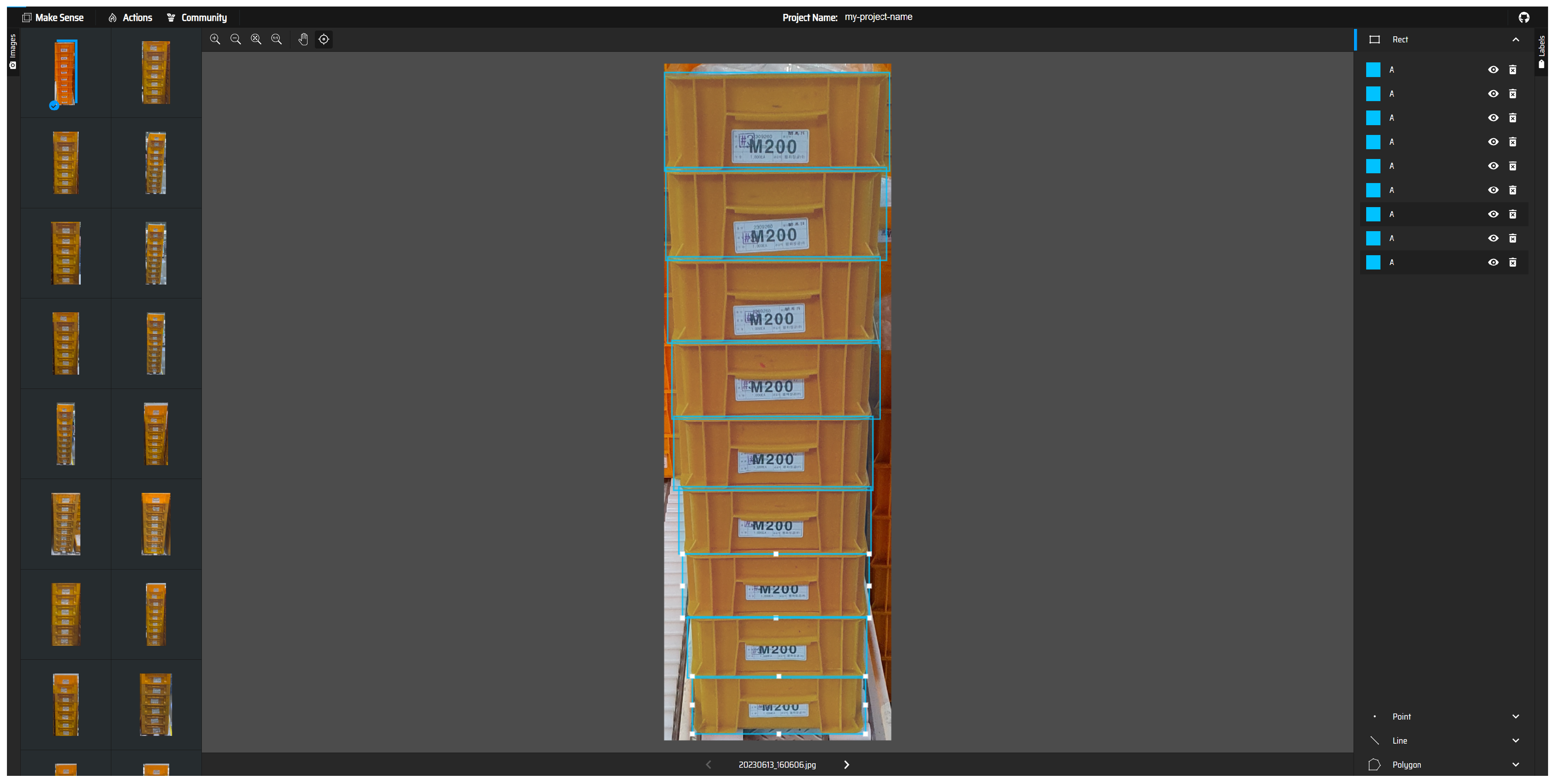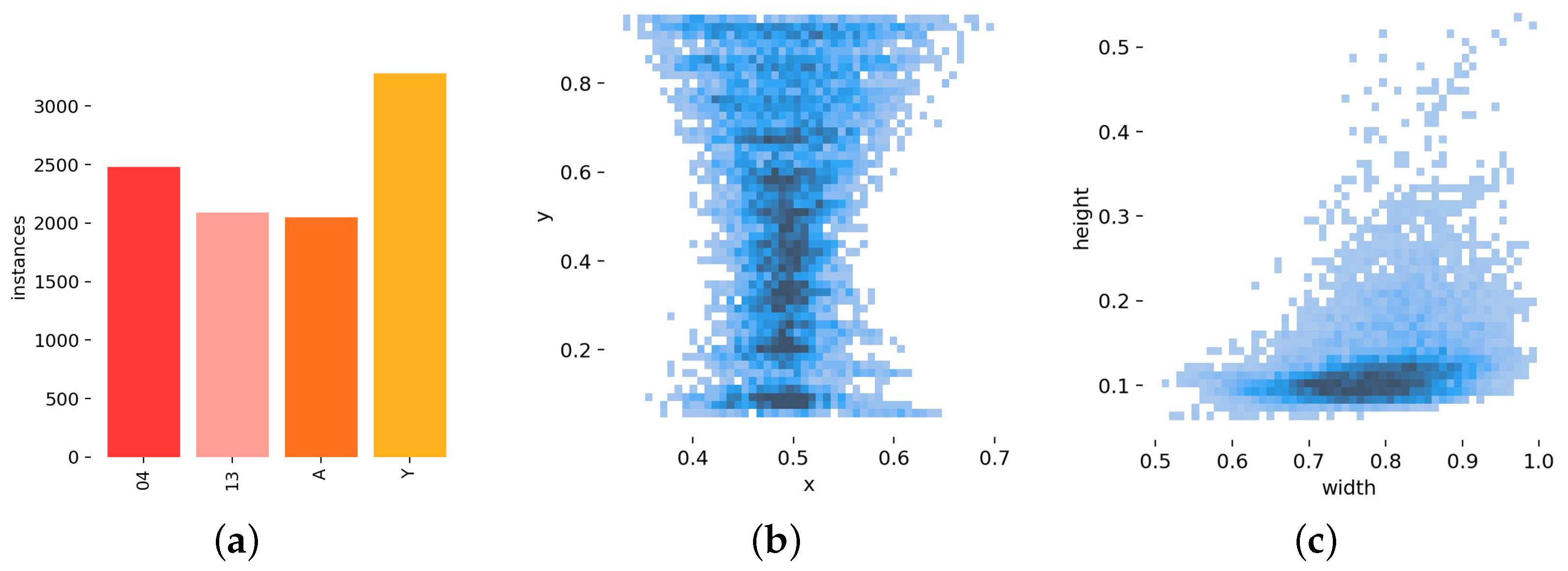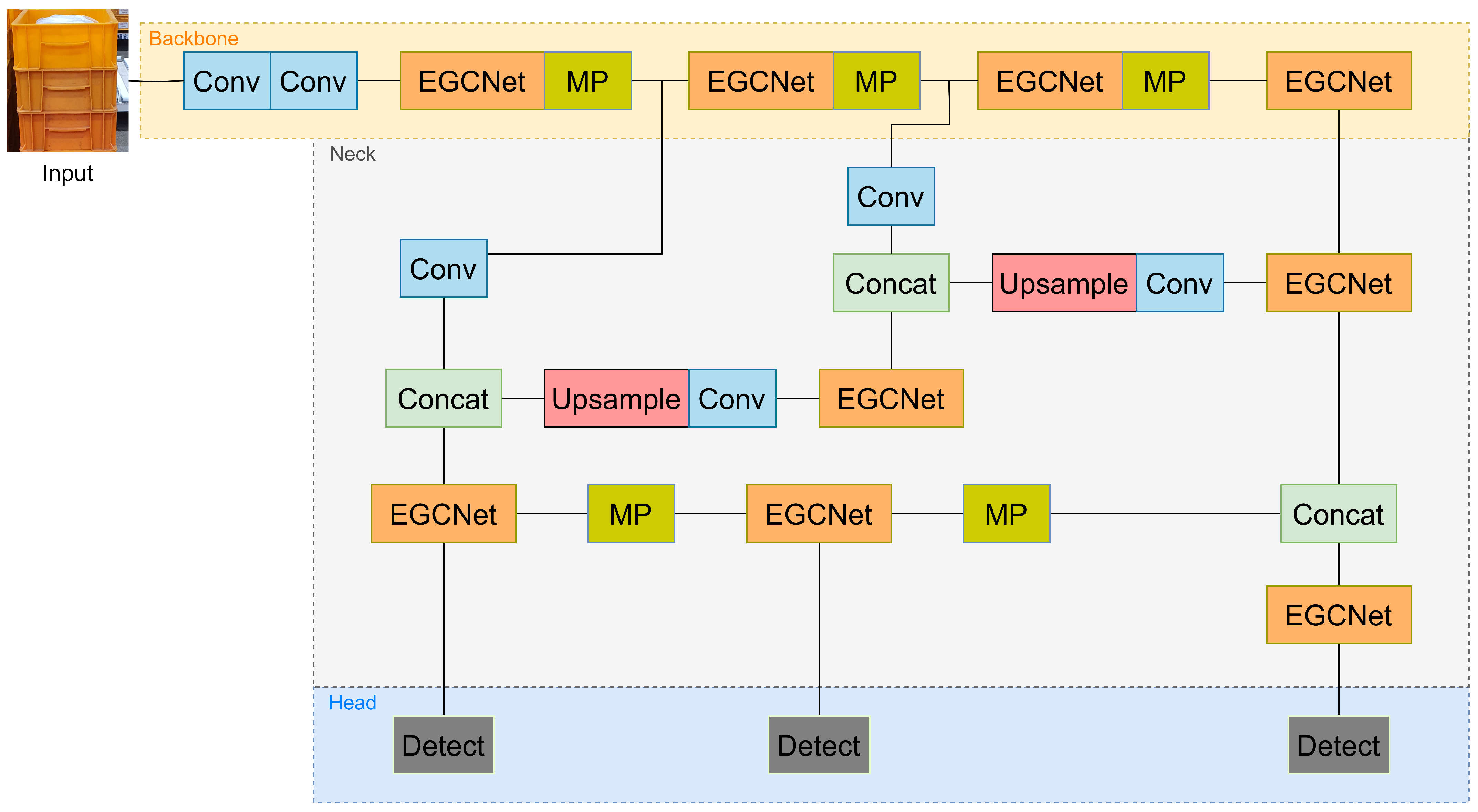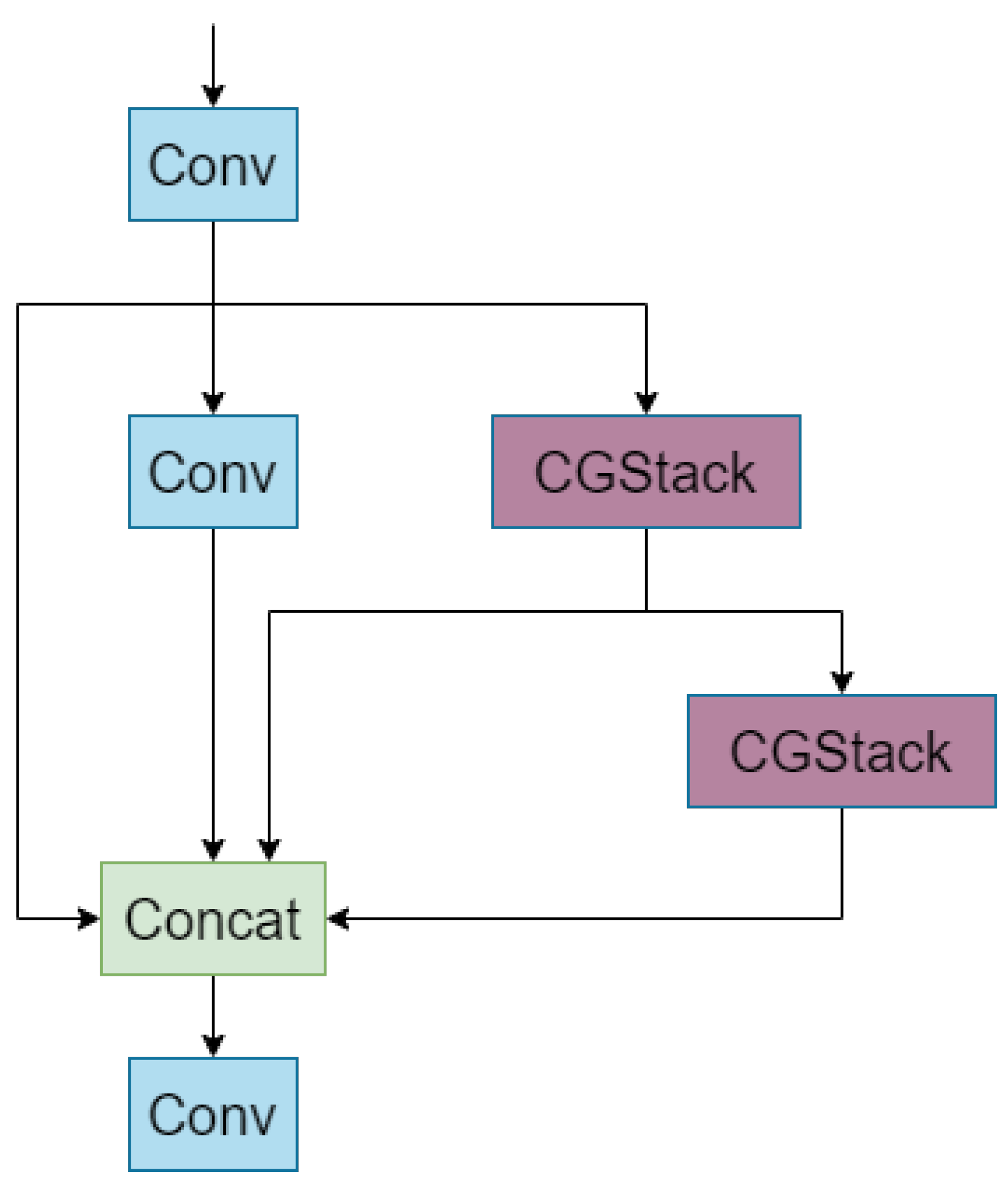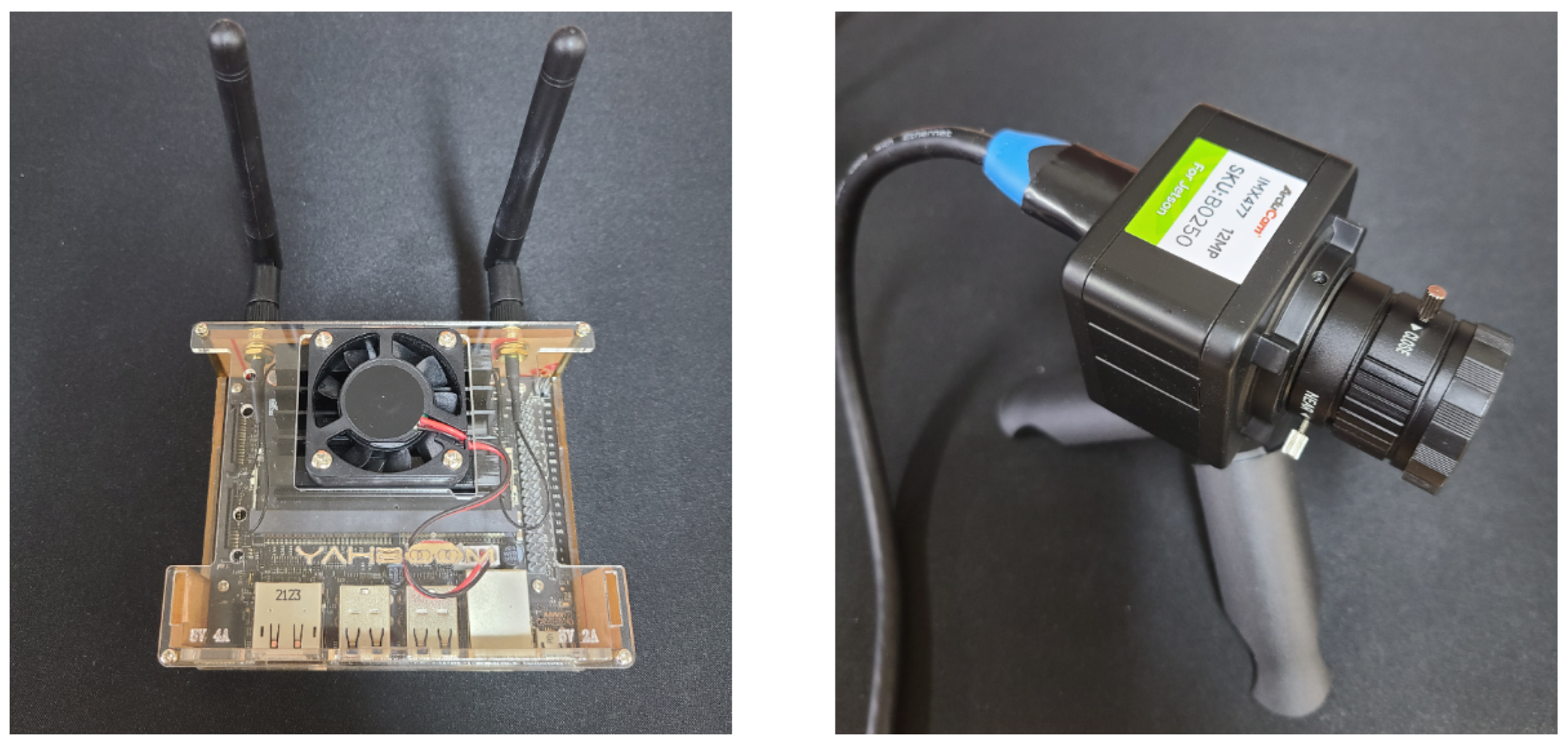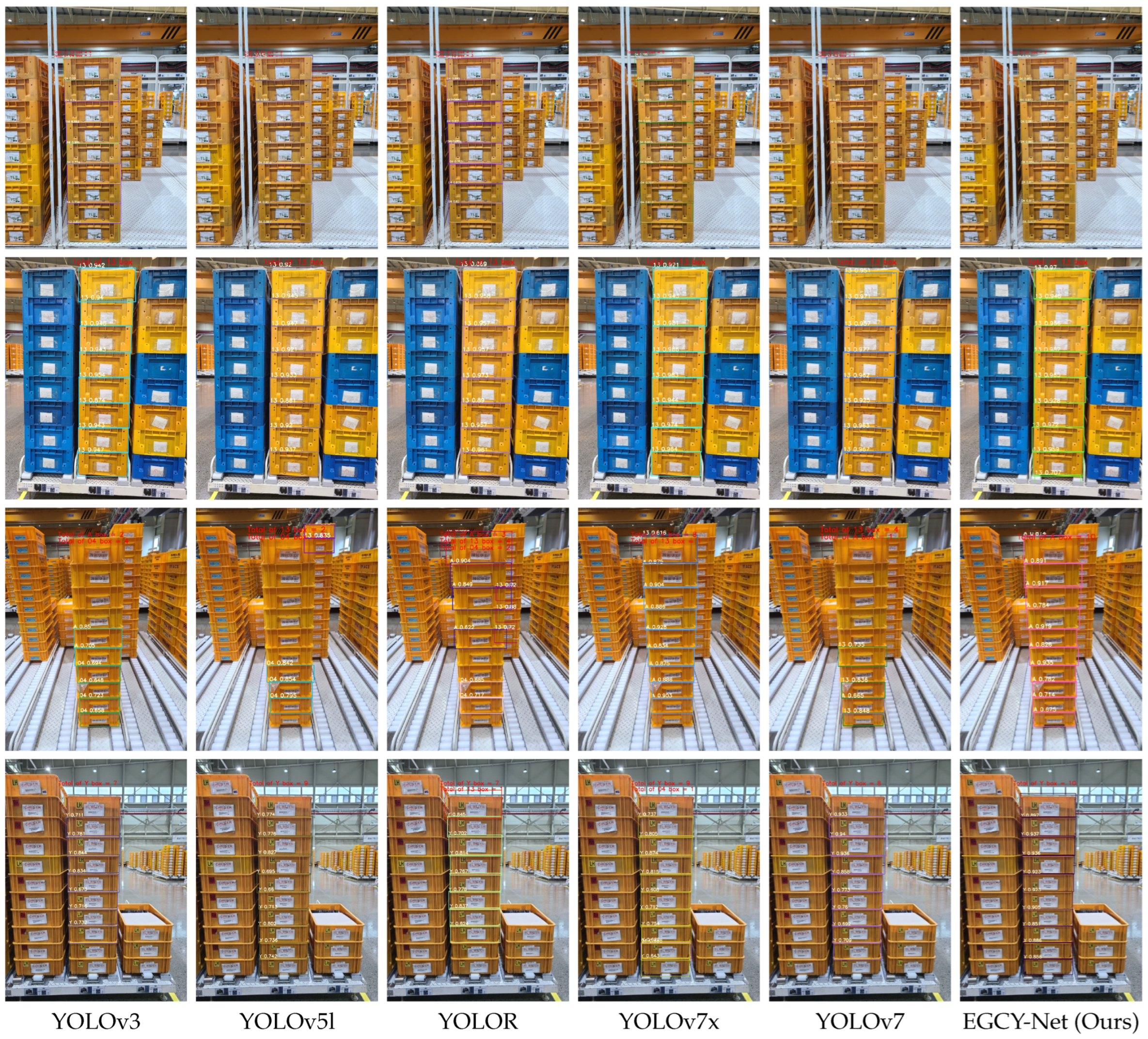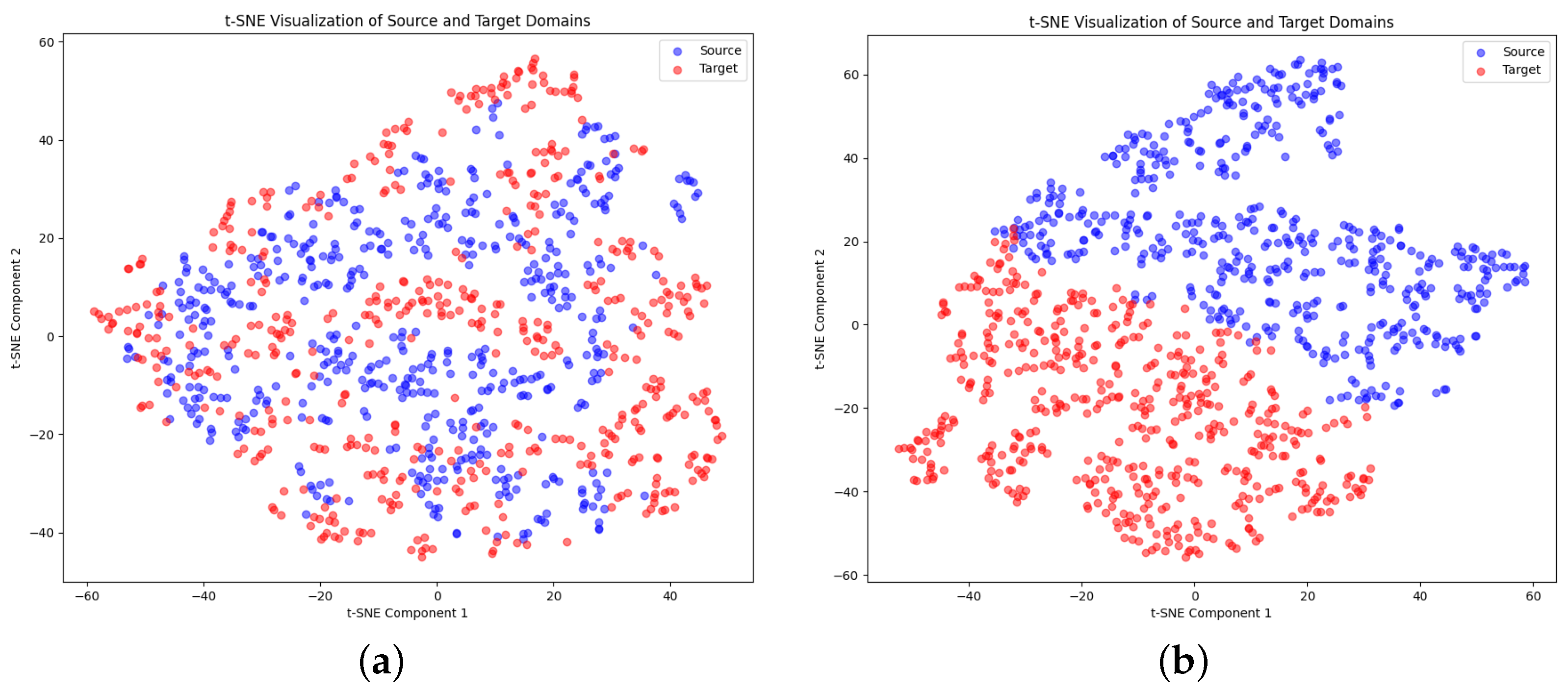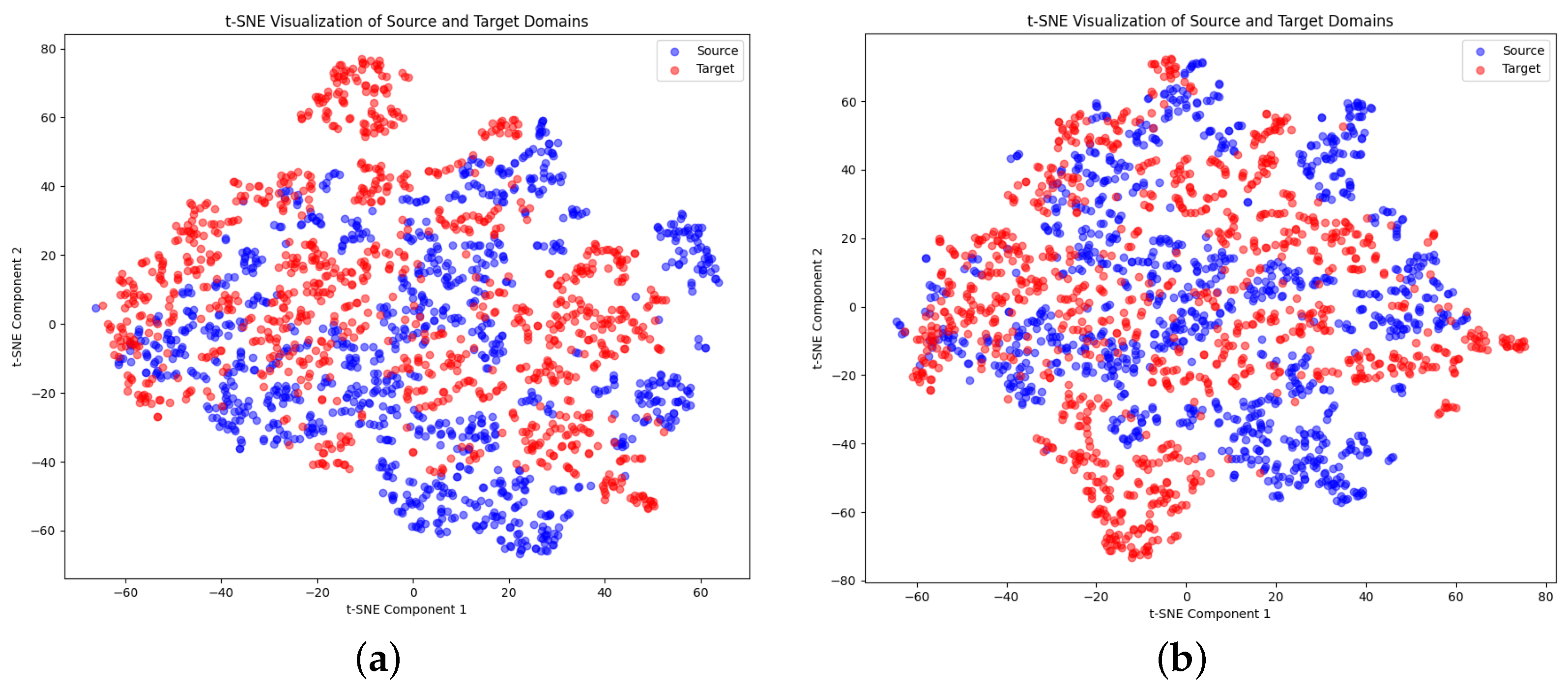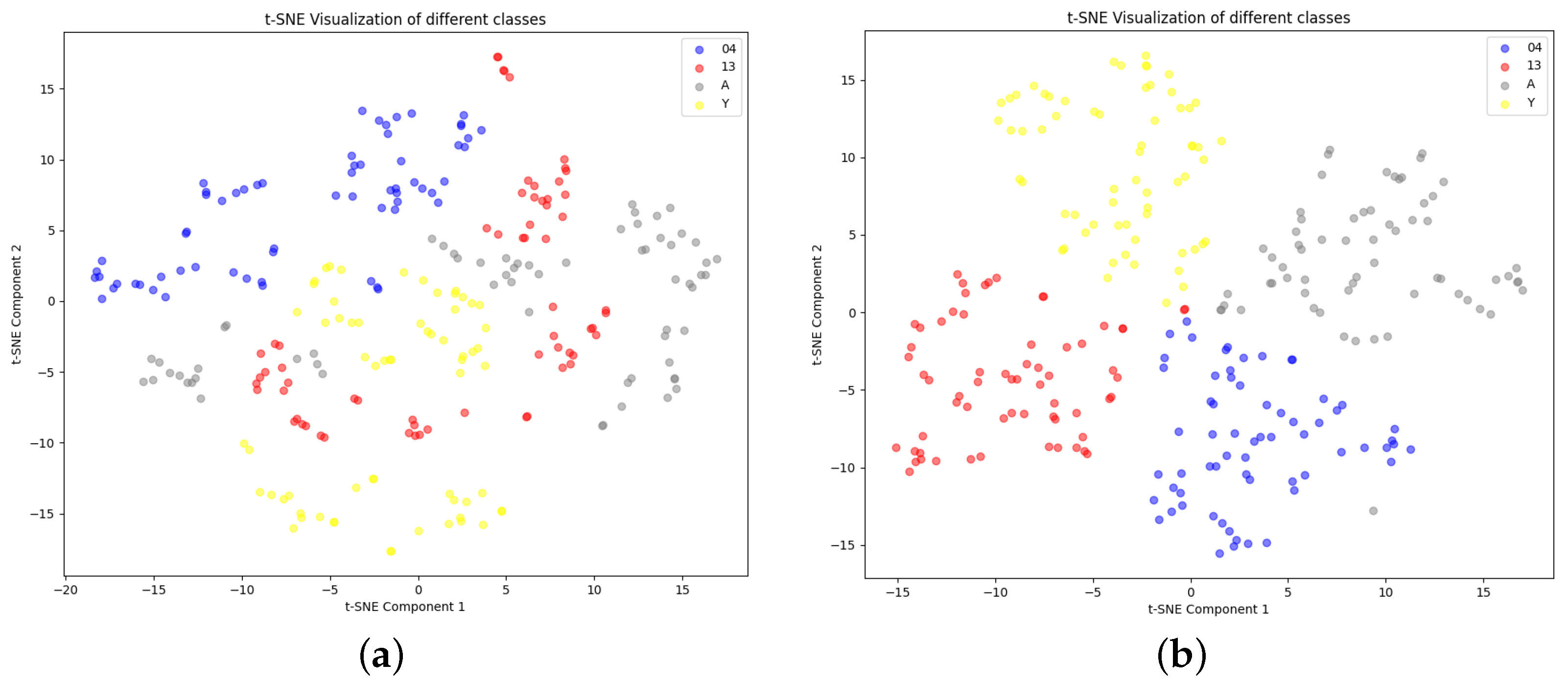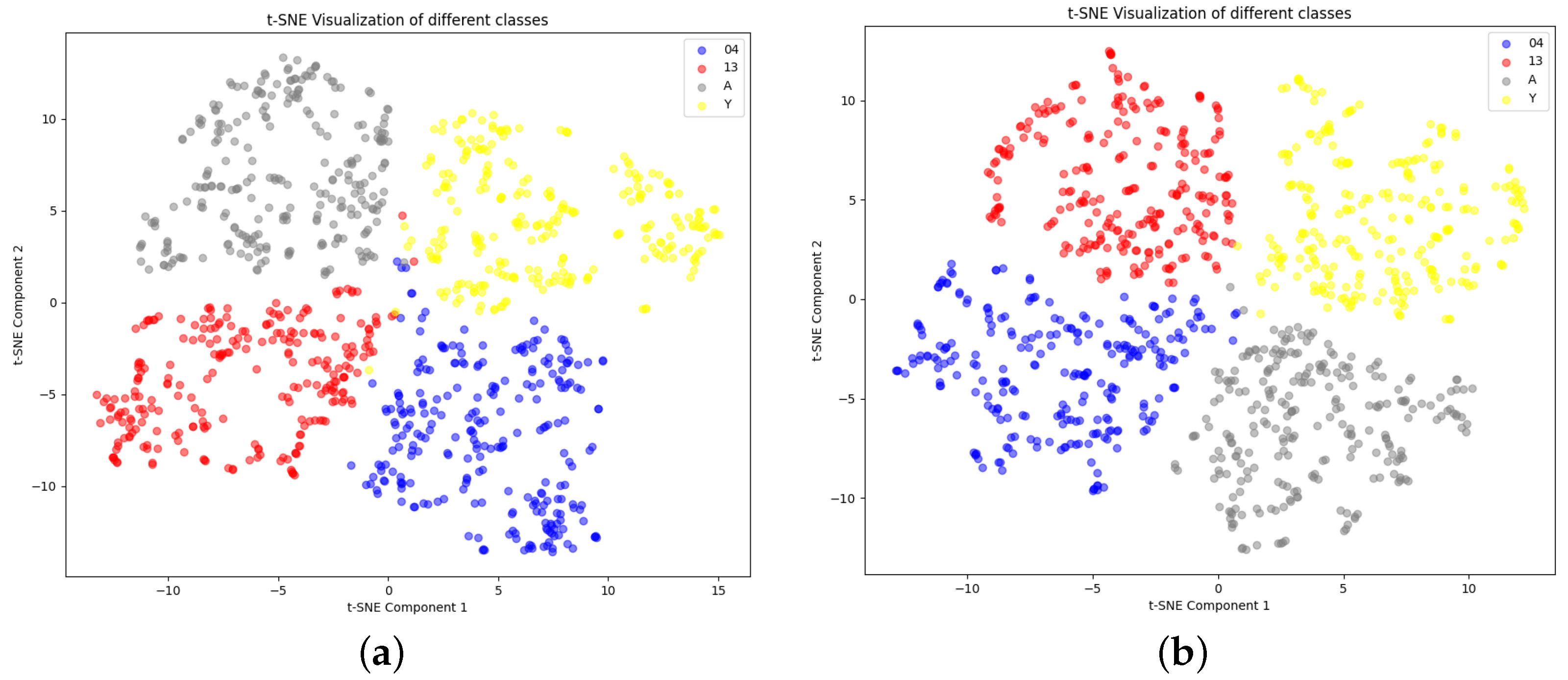1. Introduction
In supply chain management, the movement of materials and goods through several network points demands manual checks at each location. Inspections are conducted to ensure that the items being moved are correctly identified and the instructions are checked for completeness. In conventional manufacturing, stacked package recognition/movement is still a task performed by people. Owing to the time-consuming and complex factory environment, manual operations are no longer sufficient to meet production needs [
1,
2]. Automation is increasingly used across various scenarios, driven by the rapid expansion of the modern manufacturing industry. According to current trends in manufacturing and logistics, the fastest, most efficient, and least expensive system prevails in terms of logistics productivity. Since automated guided vehicles (AGVs) can operate autonomously and move things back and forth during manufacturing, they can be employed in factories to improve efficiency and quality. AGV systems function autonomously, requiring no human involvement, such as drivers. Software and sensor-based guidance systems operate together to manage their logistics. The usefulness of AGVs is that they can stimulate production by efficiently using inventory space and accelerating the logistics through automation. Additionally, because work is conducted along a prearranged route, the chance of an accident occurring can be significantly decreased [
2,
3].
Containers are used to move material between locations during manufacturing. In logistics, AGVs will move containers to a specific location based on the instructions. Since many types of containers need to be recognized by an AGV in a factory, the necessity for precision, stability, and adaptability in AGV systems is important. Thus, vision-based technology is an ideal solution as deep learning and computer vision technologies continue to improve [
4]. To enable vision-based technology, we provide an automated system for container recognition. This approach facilitates the sorting of containers, allowing them to be classified and counted more accurately and effectively throughout the manufacturing process.
RFID technology, along with integrated IT platforms, is used in logistics organizations for warehousing needs. RFID utilizes electromagnetic fields to automatically recognize and monitor tags attached to items. RFID tags, especially passive ones that do not require batteries, are highly recognized, robust, and energy-efficient, guaranteeing long-term reliability and cost-effectiveness. RFID technology has advantages in inventory management, while vision-based techniques provide more promising benefits. RFID technology offers detailed data linked to each tag, including color, measurements, and price, which is advantageous for improving inventory control. Nevertheless, this technology has limitations regarding its flexibility and adaptability. RFID systems depend on certain tags requiring appropriate infrastructure and have difficulty adjusting to environmental variations or different object categories. RFID technology may have lower accuracy in real-time object detection, which could impact the speed of responding to inventory changes. Vision-based techniques provide flexibility, adaptability, and high precision in object detection. Images, especially those in color, provide extensive information that surpasses that of other sensors. In addition to providing distance information, they also recognize an object’s color, texture, and depth. Vision systems may adjust to different environments and object categories without relying on specific tags, providing real-time and detailed information about inventory items. Additionally, vision-based technologies enable immediate responses to changes in the inventory status, making them superior options for modern logistical operations [
1,
5,
6,
7].
Automated package recognition systems have been developed by many companies. For example, a system developed by Logivations uses an automated method to identify products and their quantities. Algorithms derived from computer vision and AI are employed to decode labels, barcodes, and QR codes, read any text, and identify objects [
8]. Regarding the recognition of boxes, numerous academic research groups have conducted studies that achieved significant advancements in the identification of packing structures [
1,
4,
9,
10,
11,
12,
13]. A multi-step image processing pipeline was suggested by Dörr et al. for automated packaging structure recognition [
1]. This pipeline begins with the localization and identification of logistics transport units, followed by the convolutional neural network (CNN)-based and image processing techniques to segment visible side faces. Packaging units are consolidated and classified to produce a single RGB image that shows the structure of each unit. In [
4], Dörr and colleagues suggested using a deep learning instance segmentation model to detect and segment transport units in an input image, with the aim of recognizing and counting packages. This is followed by intra-unit segmentation to identify base pallets, transport unit sides, and package units. Information consolidation entails the allocation of packaging units to certain sides of transport units, refining the segmentation, and calculating the number of packages based on adjusted sizes. This process leads to the precise identification of packing structures inside transport units. Vasileva and Ivanovski [
9] proposed a hybrid approach that aims to perform the real-time instance segmentation of packages using 2D distance maps by integrating both deep learning and digital signal processing techniques. Li et al. [
10] suggested an approach for intelligent de-palletizing systems, which uses computer vision to recognize containers. The approach uses geometric-based structural elements, non-maximum suppression, better mean-shift clustering, and line merging. Naumann et al. [
11] suggested a method that involves reconstructing the shapes of undamaged and damaged parcels using RGB photos. It utilizes the CubeRefine R-CNN architecture, which combines 3D bounding box estimates with iterative mesh refinement. This approach allows detecting mistreatment and enables tampering detection. The study in [
12] discusses automating the unloading of containers and suggests a technique that combines a Mask-RCNN algorithm, which is based on deep learning, with 3D depth measurements to detect targets. In [
13], TetraPackNet (a unique model) is presented for segmenting objects by four vertices rather than bounding boxes or pixel masks. The model is used for recognizing the structure of logistics packaging.
Considering the related work above, there is no work similar to our research. Our research is important and difficult in that it considers the task of identifying specific types of boxes. These boxes have nearly identical shapes and are hard to separate into different layers stacked within them. For instance, in
Figure 1, we can see that box 13 and box 04 have similar shapes, leading to the misclassification of box types by a deep learning model. This paper proposes a technique that utilizes vision-based package recognition. Our task is two-fold: (1) identify an empty location within the usable storage area to load the box; and (2) identify the category and the number of boxes.
Although current detection approaches employing deep learning techniques provide high precision, they encounter many constraints, such as an excessive number of parameters, poor system runtime rates, and the occurrence of false positives. Hence, this study suggests an ELAN and GhostConv-based YOLO network (EGCY-Net) for stacked package detection that applies YOLOv7 [
14] and combines ELAN design techniques with GhostConv and other operations. The following summarizes the main contributions of this study.
To the best of our knowledge, we are the first to apply one-stage detection to tackle the task of identifying types of boxes and counting the number of boxes.
To tackle the problem of capturing complex patterns and information in the data, we propose the implementation of a Conv-GhostConv Stack (CGStack) block that consists of a 1 × 1 convolution, ghost convolution, and another 1 × 1 convolution.
The framework of the ELAN-based ghost convolution network (EGCNet) is proposed. It includes three convolution layers, two CGStack blocks, and concatenation with ELAN-based design strategies. This module helps the model to aggregate information across many layers.
We built a dataset to compare the suggested approaches (in terms of classification accuracy) with several state-of-the-art (SOTA) methods, to demonstrate the practicality and applicability of the proposed method.
By comparing our method with other SOTA methods, EGCY-Net improves the inference speed while balancing detection accuracy. It provides significant advantages to implementing this method in an embedded system.
The rest of this paper is structured as follows.
Section 2 details the EGCY-Net architecture.
Section 3 explains the results from comparison and ablation experiments. The discussion, limitations, and future works are presented in
Section 4 and
Section 5, respectively. Our conclusions are presented in
Section 6.
2. Materials and Methods
At the beginning of the process, the automated guided vehicle drives to the injection machine in order to retrieve boxes that contain raw materials. In the next step, it identifies the type of box and counts the total number of boxes. After that, the AGV transports the boxes to the barcode attachment area. As soon as the procedure is over, since the boxes might be replaced by human workers, the AGV once again recognizes the type of box and counts them. Following the completion of this procedure, a second AGV will relocate the boxes from the barcode’s attachment area to an empty location where they are to be kept.
Figure 2 presents a series of photos of the workflow. These images were captured at the Pyeong Hwa Automotive factory, Daegu, Republic of Korea.
There are two distinct activities that need to be completed in order to effectively ease the movement of boxes from various locations. The first thing that needs to be conducted is to identify the different types of boxes and determine the quantity in each category. The second task is to locate empty places in the storage sections. From a technical standpoint, our study makes use of the current developments in the field of image processing, including object classification and object identification. We applied MobileNet, a state-of-the-art neural network for object classification [
15], to identify empty spaces in areas where boxes are stored. In addition, EGCY-Net is proposed as a method to identify various types of boxes.
2.1. Box Availability Recognition
2.1.1. The Dataset
The dataset for box availability recognition has two classes: box and no box. Since the dataset will be used for classification, an image that only contains one class is needed. Initially, a video was taken in the Pyeong Hwa Automotive Factory, Daegu, Republic of Korea. However, in a real environment, there are empty spaces and box spaces in the video. Therefore, the desired region of interest (RoI) should be applied, and the video should be cropped to the desired RoI.
Figure 3 shows the image captured from the video before and after selecting the RoI.
After the RoI is selected, frames are extracted from the video, resulting in 1200 images for the ‘box’ category and 1200 images for the ‘no box’ category. All images are in JPG file format.
Figure 4 shows a sample from the box availability recognition dataset.
2.1.2. The Network Architecture
MobileNet [
15] is a family of lightweight convolutional neural network architectures designed for efficient deployment in mobile and embedded devices. The MobileNet architecture is characterized by its innovative use of depth-wise separable convolutions, which efficiently reduces the computational burden and model size. The network comprises multiple convolutional blocks, each featuring a depth-wise convolution step that processes input channels separately, significantly lowering the computational cost. This is followed by point-wise convolution that combines the features learned from depth-wise convolution, enhancing representational power. Batch normalization and activation functions are applied after each convolutional operation to normalize the output and introduce nonlinearity. Toward the end of the network, global average pooling is often applied to generate a fixed-size tensor. All layers are followed by batch norm and ReLU nonlinearity, except for the final fully connected layer, which has no nonlinearity, and feeds into a softmax layer for classification.
2.2. Box Type and Quantity Recognition
2.2.1. The Dataset
This research selected an object detection method based on deep learning. The success of deep learning in computer vision relies significantly on the availability of large datasets to avoid overfitting, especially when the neural network parameters are extensive. The more sufficient the dataset, the more effective features the model can extract, and the better the model fit. The dataset collected was captured in the Pyeong Hwa Automotive Factory. The sample images in the experiment were mainly from images and videos of boxes taken with mobile phones. All images are 1000 to 3000 pixels wide and 2000 to 5000 pixels high in a JPG file format. The dataset consists of boxes classified into four types: 04, 13, A, and Y. Several frames were extracted from the videos. Since many of the frames were identical, eliminating some of them was necessary. The final dataset contained 1258 images;
Figure 5 shows examples.
The training and inference speed of the neural network will be reduced if the image resolution is too high. Since there are many types of boxes and backgrounds in one image, we cropped images to one stack, as seen in
Figure 6. After cropping the image, more than 400 images are acquired for each class.
Labeling datasets is one of the most important steps in object detection. To make a deep learning model learn properly, we need to neatly and correctly label each object in the images. After completing the image cropping, the four box classes were manually annotated using MakeSenseAI 1.10.0-alpha [
16], as seen in
Figure 7. During the annotation process, the rectangular tool was selected to annotate each stack of boxes. The marked labels were saved as plain text files. Each image corresponds to a label file. Every line in the label file has five numbers that represent an instance. The five numbers represent the class, the center of the bounding box (x), the center of the bounding box (y), the normalized width, and the normalized height. Box information can be seen in
Table 1 and the image numbers in the final dataset are shown in
Table 2.
The numbers and distributions of objects in the training set are shown in
Figure 8.
Figure 8a shows the object names and corresponding amounts, indicating that the dataset encompasses an adequate number of instances for each box type.
Figure 8b shows the distribution of tags. The x-axis is the ratio of the label center to the image width, and the y-axis is the ratio of the label center to the image height. As seen in the figure, the data are widely distributed and concentrated in the middle of the image.
Figure 8c shows the sizes of the objects. The x-axis is the ratio of the label width to the image width, and the y-axis is the ratio of the label height to the image height.
2.2.2. The EGCY-Net Architecture
The network structure for EGCY-Net proposed in this paper is shown in
Figure 9; it is mainly composed of the backbone, neck, and head. This network was constructed based on YOLOv7 code, but most of the EGCY-Net structure is different from YOLOv7 [
14].
The EGCY-Net backbone contains Conv, EGCNet, and MP layers, which are used for feature extraction to ensure completeness. The EGCY-Net neck includes Conv, Upsample, MP, concatenation, and EGCNet with multi-scale feature fusion mode to integrate low-level spatial information and high-level semantic features to preserve more details and improve detection accuracy. This combines feature information at different scales. It continues to extract features from valid feature layers already obtained, upsampling them for feature fusion, and downsampling the features again for feature fusion. The head selects IDetect Head with three target sizes: large, medium, and small. The head is used as a classifier and regressor, and through the backbone and neck, three enhanced adequate feature layers are obtained, which are input for the head in decoupling feature information to output the position, confidence, and target type.
2.2.3. The GhostConv Module
Neural networks usually contain extensive numbers of parameters, particularly in fully connected layers. The advancement of convolutional neural networks has made it possible to use filters that drastically cut down on the number of parameters. In order to create a network suited to performing detection tasks, a large model is generally required, which in turn demands a lot of feature maps, each of which typically contains hundreds of channels. The model is bloated because of the number of layers, even in SOTA models. By reducing the number of parameters in a neural network, we can make it easier to deploy on devices. Illustrations of the convolution layer and GhostConv are presented in
Figure 10.
The input feature map is represented by
, where
c denotes the number of channels in the input feature map, and
h and
w denote the feature map’s height and width, respectively. The standard convolution method is presented in Equation (
1), as follows:
In that equation,
represents an output feature map with
n channels, where
and
represent the height and width, respectively, of the output feature map. The convolution filters are denoted by
, and ∗ indicates the convolution operation. The size of the convolution kernel is
, and
b represents the bias term. The regular convolution computation, excluding the bias term, is approximately equal to
. In a shallow layer of the network, the values of
and
are more expansive, whereas in a deeper layer, the values of
n and
c are larger. The ghost convolution [
17] method was introduced, which comprises two components: a regular convolution kernel that produces a limited number of feature maps and the creation of additional feature maps in a lightweight linear transform layer. This can be mathematically represented as follows:
Equation (
2) represents a standard convolutional layer that produces only a small number of feature maps. Here,
represents the resulting feature output, and
represents the size of the convolutional kernel used. The output feature map has fewer channels compared to the standard convolutional layer, specifically
.
The linear transformation layer—responsible for producing redundant feature maps—is represented by Equation (
3), where
represents the
feature maps of
. In order to generate
feature maps, a lightweight linear transformation operation is applied to each feature map in
. When the
convolution is employed as the linear transform, the final linear transform is mandatorily specified as a constant transform. Consequently, linear transformations of the
feature maps yield
m feature maps. Using ghost convolution, the total computation is
.
2.2.4. The Conv-GhostConv Stack (CGStack) Module
A standard convolutional layer in a neural network is denoted with Conv. The layer has batch normalization (nn.BatchNorm2d) and the SiLU activation function to make the data less linear. Based on the Conv layer, GhostConv is proposed to reduce the parameters. The ghost convolution method splits the convolutional operation by dividing input channels into two groups and employing 1 × 1 and 3 × 3 convolutional kernels for feature extraction. The results are then combined in the concatenation layer.
The bottleneck structure [
18] consists of three layers: a 1 × 1 convolutional layer with fewer filters, the reduced-dimension representation processed by a 3 × 3 convolutional layer, and another 1 × 1 convolutional layer to restore dimensionality to the original size. In CGStack, the 3 × 3 convolutional layer in the bottleneck structure is replaced with a ghost convolution, introducing a different type of operation into the architecture. Ghost convolution is a technique designed to reduce computational costs and the model size by approximating the output of a standard convolutional layer. Based on Conv and GhostConv [
17], CGStack is proposed to enhance the flexibility and efficiency of convolutional layers in deep learning architectures, which can be seen in
Figure 11. This convolution layer in the module helps the model enhance the inter-channel relationship and the GhostConv layer reduces the number of parameters while preserving the ability to capture spatial features. The module allows the network to efficiently learn both low-level and high-level features: edges, colors, textures, shapes, and the entire object in the image.
2.2.5. The ELAN-GhostConv Network
Model scaling refers to the process of adjusting the size of a pre-existing model to ensure compatibility with various computing devices, whether it be increasing or decreasing its dimensions. The model scaling method commonly employs various scaling factors, such as resolution (input image size), depth (layer number), width (channel number), and stage (feature pyramid number), to achieve an optimal compromise between the network parameters, computation, inference speed, and accuracy [
19,
20,
21]. During the process of model scaling, a problem occurs when the network reaches a specific depth. If we continue to add computing blocks, the accuracy will gradually diminish. Furthermore, once the network reaches a certain depth, its convergence starts to decline, leading to overall accuracy that is inferior to that of shallow networks [
22].
The main purpose of designing ELAN [
22] is to address the issue of gradual degradation in deep model convergence during model scaling. The ELAN structure helps to analyze the shortest and longest gradient pathways throughout each layer in the network, enabling the creation of a layer aggregation architecture that ensures the effective propagation of gradients. According to the previous explanation, we put forward a network that has a comparable ELAN structure to enrich features from aggregation layers. To achieve this, we utilize Conv, the CGStack module, and concatenation to construct EGCNet. The proposed EGCNet structure is depicted in
Figure 12.
2.3. Counting the Boxes
Once the box class has been identified, the next task is to ascertain the quantity of boxes. This approach is specifically designed to calculate the number of boxes within cropped frames corresponding to the region of interest (RoI). The box is considered valid if its dimensions surpass the minimum height and width specifications and if the score exceeds 50. Subsequently, a class will be generated for each box detected, and the number of boxes will be calculated based on the output of the class. Algorithm 1 is a pseudocode for the proposed method of counting boxes.
| Algorithm 1: Box counting pseudocode |
![Applsci 14 02763 i005]() |
2.4. Implementation
Deep learning algorithms have significant computing costs throughout the training process, particularly when dealing with large-scale datasets. This research utilized NVIDIA’s Jetson Nano and the Arducam IMX477 camera from ArduCAM (
Figure 13). The Jetson Nano is a compact high-performance microprocessor specifically engineered to operate as an embedded device running artificial intelligence applications. The Jetson platform is equipped with a 64-bit ARM quad-core CPU, a 128-core integrated NVIDIA GPU, and 4 GB of LPDDR4 memory. The Jetson Nano is useless without an operating system. Therefore, from a micro SD card, we installed JetPack 4.6.1, which uses L4T version R32.7.1.
The Arducam CSI-USB UVC Camera Adapter Board was utilized for the 12.3 MP IMX477 camera. A dual-core NVIDIA GeForce RTX 4090 GPU was employed in the experiments during training to facilitate the training and assessment of the object detector model. The operating system used was Linux, supplemented with NVIDIA CUDA 11.8 and cuDNN 8.1 for GPU acceleration.
Once the MobileNet and object detector models are trained, they must be converted from PyTorch (.pt) to ONNX format. The ONNX format can be beneficial when implementing the model on devices like the Jetson Nano because it is a more widely supported format for inference across various frameworks and hardware platforms. The interoperability of the ONNX format enables its utilization across a multitude of deep learning frameworks and hardware accelerators. By converting the model to ONNX format, the probability that it can be executed on the Jetson Nano increases.
4. Discussion
It is challenging to detect objects with images captured by different camera lenses. In this experiment, we used images captured by a smartphone camera to train the model. However, in a real-time application, the Arducam camera was used. The differences in camera lenses may have an impact on the results. Therefore, we tested the model using a smartphone camera at first. YOLOv7 [
14], YOLOv7x [
14], YOLOR [
25], YOLOv5l [
24], and YOLOv3 [
23] presented poor performance. For instance, detections by YOLOv3 [
23], YOLOv5l [
24], YOLOR [
25], and YOLOv7 [
14] had false detection for Class 04 in the first row. Furthermore, YOLOv7x [
14] accurately identified the classes but missed one box. All models in the second row performed admirably with the Class 13 box. YOLOv3 [
23], YOLOv5l [
24], YOLOR [
25], YOLOv7x [
14], and YOLOv7 [
14] demonstrated inferior performance in detecting Class A in the third row. Class Y in the last row was correctly detected by YOLOv3 [
23], YOLOv5l [
24], and YOLOv7 [
14], with only a few missed detections. Additionally, both YOLOR [
25] and YOLOv7 [
14] had false detections. However, EGCY-Net can recognize the box type correctly in smartphone images.
The proposed method was good at extracting features from the Arducam images of Classes 04 and 13, while YOLOv3, YOLOv5l, YOLOR, YOLOv7x, and YOLOv7 had missed and wrong detections. As seen in the third and fourth rows (Classes A and 13), all models had missed and false detections. However, among them, our proposed network and YOLOv7x showed better results for Class A (detecting nine boxes for Class A) but one false detection for Class 13. Meanwhile, the other models had false detection for three out of the four classes. For Class Y in the last row, all models had false detection, but YOLOv3 and YOLOV5 made better decisions for Class Y (nine correct detection). Based on the above, EGCY-Net had better results in detecting boxes in Arducam images and had the lowest ONNX size.
